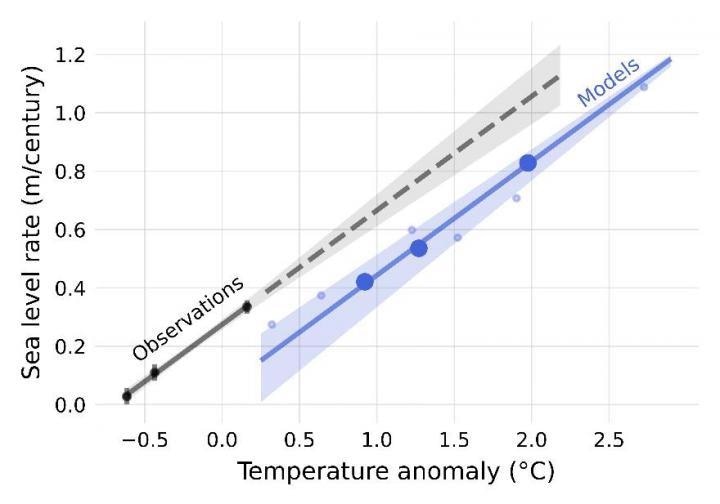Feb 3 2021
When assessing the rise in sea levels, two major elements should be observed. One element is the loss of ice on land, for example, inland ice sheets and melting mountain glaciers on Antarctica and Greenland, while the other is that the sea will increase in size as it becomes warmer. In other words, the sea level will rise quickly with increasing temperatures.
 The warmer it gets, the faster the sea level rises. the sensitivity models of the future appear to be inconsistent with historical data. Image Credit: Aslak Grinsted.
The warmer it gets, the faster the sea level rises. the sensitivity models of the future appear to be inconsistent with historical data. Image Credit: Aslak Grinsted.
Now, scientists from the Niels Bohr Institute at the University of Copenhagen have developed a new technique to precisely measure how fast the sea will respond to warming.
The sea level is tracked carefully and its responsiveness can be compared in models using ancient data. The comparison demonstrates that previous estimations of sea level have been extremely conservative, which means the sea will probably rise more and faster than assumed.
The study results were recently published in Ocean Science, the journal from the European Geosciences Union.
Over the last 150 years, in what is said to be the industrial period, sea levels have been rising, as explained by Aslak Grinsted, an associate professor from the Niels Bohr Institute research section, Physics of Ice, Climate and Earth.
We expect, of course, that there is a connection between rising temperature and the rate indicating the momentum of the rise. Observations are telling us that the rate has been accelerating over the past 150 years. This means we can create a picture of how the connection between temperature and sea-level rise has been, historically.
Aslak Grinsted, Associate Professor, Niels Bohr Institute, University of Copenhagen
Grinsted continued, “But 150 years is not very long, actually, because of the great inertia in the warming of the oceans and inland ice sheets, so several hundreds of years can pass before we see the full consequences of warming in the atmosphere. This is why we compare the observations with the results from the detailed computer models we use to depict a future scenario.”
“Among others, the climate panel of the United Nation's Intergovernmental Panel on Climate Change (IPCC), has gathered these projections, made from a collection of many smaller models. These, in turn, have been validated, obviously, as well as can be done,” he added.
Sea Level Projections are a Fairly Complicated Game
The IPCC used predictions that are built on a jigsaw puzzle of models for glaciers, ice sheets and the rising temperature of the sea. But the predictions suffer as only a reduced volume of data is, at times, available for the models to be verified on.
No data was practically available on the melt-off rate for Antarctica before there was coverage from satellite observations earlier in the 1990s.
We have better historical data for the sea-level rise in total, which, in principle, allows for a test of the combined puzzle of models. However, it has not been part of the routine to make sea-level hindcasts at IPCC, so presently we are not able to tell if these models are capable of reproducing the historical sea level.
Aslak Grinsted, Associate Professor, Niels Bohr Institute, University of Copenhagen
“At the Niels Bohr Institute, we have used this situation as our starting point, and so we observe how sensitive the models are in reacting to warming. We expect that if we compare observational data from the fairly short period of time from 1850 onwards with the sensitivity of the models, it should allow us to assess whether the models are realistic or not,” Grinsted explained further.
Models do Not Match Historical Observations
The researchers from the Niels Bohr Institute believe that their technique for verifying upcoming situations by delving into the past can gain a foothold in how the rise in sea levels will be examined in the days to come.
Apparently, the models we are basing our predictions of sea-level rise on presently are not sensitive enough. To put it plainly, they don’t hit the mark when we compare them to the rate of sea-level rise we see when comparing future scenarios with observations going back in time.
Aslak Grinsted, Associate Professor, Niels Bohr Institute, University of Copenhagen
“It is crucial for our faith in model-based climate predictions that they are able to reproduce the realized climate as realistically as possible,” added Jens Hesselbjerg Christensen, a Professor at the Ice, Climate and Geophysics Section from the Niels Bohr Institute and the co-author of the study.
Professor Christensen continued, “We hope this new comparison metric will be adopted to as large extent as is possible and can become a tool we can apply in comparing different models. A good example is that we don’t expect the sensitivity to be the same all the way back to the last millennium or several millions of years back in time, but the added understanding of how the sensitivity might change over time is something we can add to the comparisons between models and observations.”
“Besides, we’d like to see the method applied to the individual processes contributing to sea-level rise. This might make the understanding of the sensitivity even more detailed, we believe,” added Professor Christensen.
“You could say that this article has two main messages: The scenarios we see before us now regarding sea level rise are too conservative—the sea looks, using our method, to rise more than what is believed using the present method. The other message is that research in this area can benefit from using our method to constrain sea-level models in the scenarios in the future,” Grinsted concluded.